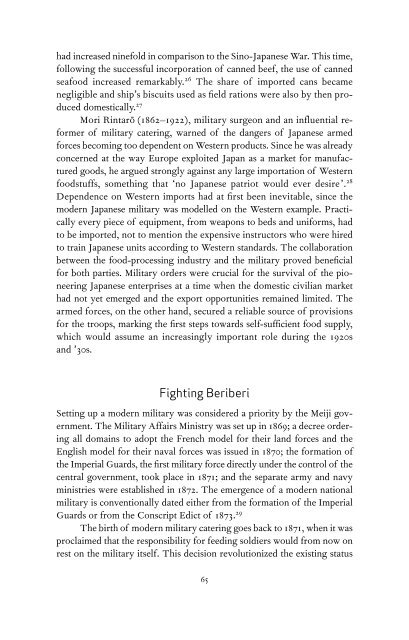Download - Brainshare Public Online Library
Download - Brainshare Public Online Library
Download - Brainshare Public Online Library
You also want an ePaper? Increase the reach of your titles
YUMPU automatically turns print PDFs into web optimized ePapers that Google loves.
had increased ninefold in comparison to the Sino-Japanese War. This time,<br />
following the successful incorporation of canned beef, the use of canned<br />
seafood increased remarkably. 26 The share of imported cans became<br />
negligible and ship’s biscuits used as field rations were also by then produced<br />
domestically. 27<br />
Mori Rintarō (1862–1922), military surgeon and an influential reformer<br />
of military catering, warned of the dangers of Japanese armed<br />
forces becoming too dependent on Western products. Since he was already<br />
concerned at the way Europe exploited Japan as a market for manufactured<br />
goods, he argued strongly against any large importation of Western<br />
foodstuffs, something that ‘no Japanese patriot would ever desire ’. 28<br />
Dependence on Western imports had at first been inevitable, since the<br />
modern Japanese military was modelled on the Western example. Practically<br />
every piece of equipment, from weapons to beds and uniforms, had<br />
to be imported, not to mention the expensive instructors who were hired<br />
to train Japanese units according to Western standards. The collaboration<br />
between the food-processing industry and the military proved beneficial<br />
for both parties. Military orders were crucial for the survival of the pioneering<br />
Japanese enterprises at a time when the domestic civilian market<br />
had not yet emerged and the export opportunities remained limited. The<br />
armed forces, on the other hand, secured a reliable source of provisions<br />
for the troops, marking the first steps towards self-sufficient food supply,<br />
which would assume an increasingly important role during the 1920s<br />
and ’30s.<br />
Fighting Beriberi<br />
Setting up a modern military was considered a priority by the Meiji government.<br />
The Military Affairs Ministry was set up in 1869; a decree ordering<br />
all domains to adopt the French model for their land forces and the<br />
English model for their naval forces was issued in 1870; the formation of<br />
the Imperial Guards, the first military force directly under the control of the<br />
central government, took place in 1871; and the separate army and navy<br />
ministries were established in 1872. The emergence of a modern national<br />
military is conventionally dated either from the formation of the Imperial<br />
Guards or from the Conscript Edict of 1873. 29<br />
The birth of modern military catering goes back to 1871, when it was<br />
proclaimed that the responsibility for feeding soldiers would from now on<br />
rest on the military itself. This decision revolutionized the existing status<br />
65







